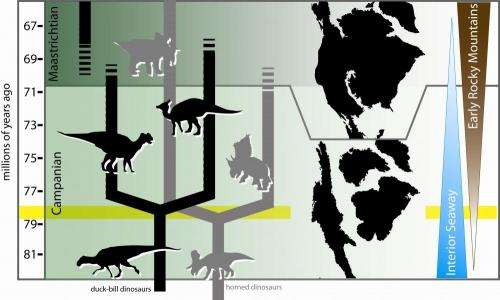Mountains, seaway triggered North American dinosaur surge

The rise of the Rocky Mountains and the appearance of a major seaway that divided North America may have boosted the evolution of new dinosaur species, according to a new Ohio University-led study.
The finding, published today in the journal PLOS ONE, may explain patterns of evolution and migration of North American duck-billed and horned dinosaurs in the years leading up to their extinction 65 million years ago, said Terry Gates, a postdoctoral researcher with Ohio University's Heritage College of Osteopathic Medicine who is lead author on the study.
"Over the past century, paleontologists have found a wide variety of dinosaurs in rocks dating to around 75 million years ago, but right before the asteroid hit at the end of the Cretaceous, there appeared to be fewer species in North America," he said. "The reason for this discrepancy in dinosaur diversity has never been adequately explained."
Gates and collaborators Albert Prieto-Márquez and Lindsay Zanno turned to the geologic record of western North America for possible answers. They examined trends in mountain and ocean formation during a period 80-70 million years ago, when there was an apparent explosion of dinosaur species, and later, when species became less diverse.
The record painted a picture of pronounced geological change.
During the early to middle Cretaceous, geological forces lifted the western United States, creating a huge mountain range (the Sevier Mountains) that extended in a line from the American southwest through Alberta, Canada. The area just to the east of the new mountain range flexed downward, creating a shallow North American seaway (known as the Western Interior Seaway) that flooded the continent from the Canadian arctic to the Gulf of Mexico.
This seaway cut the continent into three large islands to the north, east and west that were densely populated with dinosaurs. The dinosaurs of the west lived on an island known as Laramidia. Most fossil discoveries have been made in the area of the northern part of the island, in places such as Alberta, South Dakota and Montana, while dinosaurs have been found only recently in the former areas of southern Laramidia.
"Western North America has been a hotbed for dinosaur discoveries for more than a century," Zanno noted, "but the recent explosion of new dinosaur species coming out of Utah is sending waves through the paleontological community and revolutionized our understanding of dinosaur evolution on the continent."
The new discoveries have helped illustrate how dinosaurs evolved on an island with changing geography. The rise of the Sevier Mountains and the growing seaway caused dinosaur habitat to shrink on Laramidia. Later, one of the tectonic plates under North America's crust shifted position, building another mountain range—the Laramide Orogeny, or the infant stage of the modern-day Rocky Mountains—further east.
"At that time, it appears that geographic, as well as probably also ecological, barriers created by the rise of mountain ranges and the seaway caused isolation of the northern and southern populations of the crested duck-billed and horned plant-eating dinosaurs. We hypothesize that such isolation facilitated rapid speciation and increased diversity in these animals," explained Prieto-Márquez.
The new species of duck-billed and horned dinosaurs were being born at an astounding rate of every few hundred thousand years during the brief time when the two mountain ranges and the seaway coexisted, Gates said. "Isolating populations allows them to evolve new features more rapidly, especially when skull ornamentation such as head crests and horns play a role," he said.
Eventually, however, the continued rise of the Rocky Mountains would evict the seaway from the continent's interior. Gates and his colleagues argue that this second geological change opened up a wide territory for duck-billed and horned dinosaurs to roam, that, in turn, reduced how fast new species evolved in the region to every few million years.
"Our data suggests that changing geography contributed to the pattern we see in western North America, but also that this pattern is unique to this region and should not be blindly extrapolated to infer global diversity leading up to the K-T extinction event," Zanno noted.
The study also found that the same species of at least some duck-billed dinosaurs lived from Canada through southern Utah at some points in the Cretaceous. Yet, during the times of isolation, these giant plant-eaters "roamed a much smaller area than you might think given that many were larger than elephants," Gates noted. Scientists hypothesize that there are ecological as well as geological reasons behind this, including the possibility that dinosaurs evolved to eat specialized plants found only in certain regions.
The mountain and seaway changes not only impacted dinosaur diversity in North America, but may have had implications in other parts of the world. Global geological changes during this time created migration routes to Asia and South America. The team speculates that the rise of the early Rocky Mountains in North America created a barrier. Only species living in the southern part of Laramidia island could get to South America and only species living north of the mountains would have been able get to Asia across modern-day Alaska.
"These giant herbivores were truly invasive species that seemingly came to dominate these other continents," said Gates, adding that this idea needs to be tested further with additional fossil remains.
More information: PLOS ONE paper: dx.plos.org/10.1371/journal.pone.0042135
Journal information: PLoS ONE
Provided by Ohio University


















